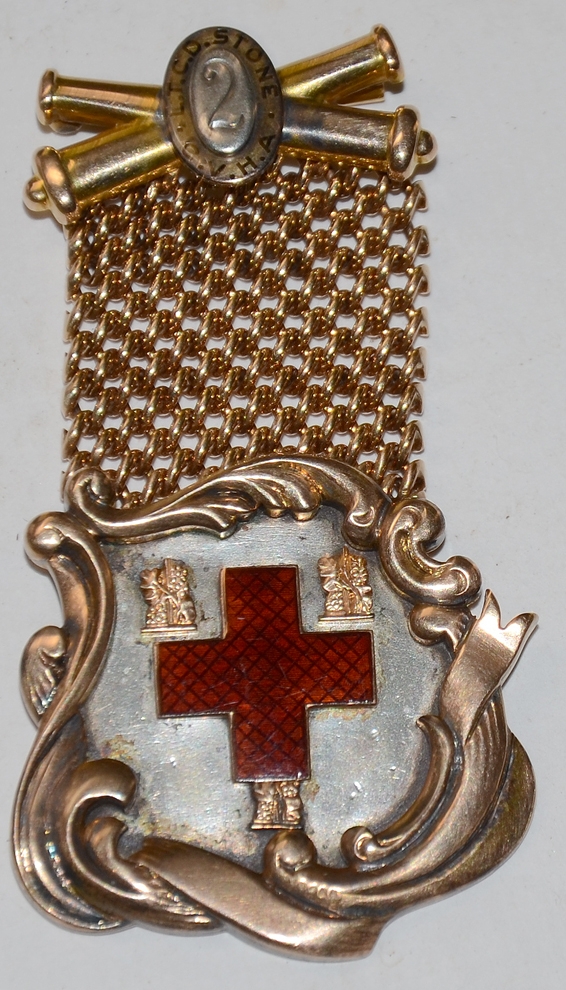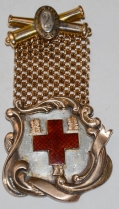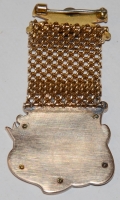site search
online catalog
WONDERFUL 2nd CT HEAVY ARTILLERY CORPS BADGE WITH STATE SEAL – GEORGE DWIGHT STONE

$850.00 SOLD
Quantity Available: None
Item Code: 30-2226
This impressive badge incorporates on the gilt top bar with pin back a pair of crossed cannons surmounted at center with oval reading “LT. G.D. STONE” around the upper edge, a large “2” on a smaller raised oval at center, and “C.V.H.A.” along the bottom edge. From this extends a gold mesh ribbon of links that secure a drop with a raised gilt border or rococo raffles and flowing leaves and ribbons. The interior is silver and mounted at center with a gold-bordered red enamel Sixth Corps badge. Attached on either side of the upper branch of the cross and below the lower branch are small gilt grapes and grapevines that imitate the Connecticut state seal by their content and arrangement.
George Dwight Stone was a resident of Litchfield County, CT, born in 1839, enlisting 26 July 1862 and mustering in 11 September 1862 as a private in Co. A. He was promoted Corporal 13 Feb. 1864; Sergeant 8 March 1864; and 2nd Lieutenant of Co. C 23 Feb 1865. He mustered out 18 August 1865. After the war he lived in Union County, New Jersey, and was commander of Ulric Dahlgren Post 25 in Elizabeth in 1908. He died in New Jersey in 1931 and is buried in Evergreen Cemetery in Hillside, NJ.
The Second Connecticut Heavy Artillery saw heavy action serving as infantry from May 1864 through April 1865. Known as the Litchfield County Regiment and first recruited for infantry duty in July 1862, it was designated the 19th CT, it was mustered into service in September, spending its first year of service on garrison duty in the defenses of Washington and Alexandria. In November 1863 it was changed from infantry to heavy artillery and recruited up the appropriate bigger strength, but, ironically, in May 1864 was one of the heavy artillery regiments called into the field for service as infantry in Grant’s Overland Campaign. It was assigned to the Sixth Corps, seeing action at Spottsylvania, Totopotomoy, Hanover Court House, Cold Harbor and Petersburg before moving in July to Washington to counter Early’s attack and following him as part of the Army of the Shenandoah, with further action at Winchester, Fisher’s Hill, and Cedar Creek. They returned to the Army of the Potomac in December and saw more fighting at Petersburg, including the final assault on April 2, 1865, and the pursuit of Lee, with fighting at Sailor’s Creek on April 6. After Lee’s surrender they marched to join Sherman, but were turned back with announcement of Johnston’s surrender. They took part in the Grand Review in June and began mustering out in July. They lost 12 officers and 242 officers and enlisted men in killed and wounded alone, with the greatest concentrated losses at Cold Harbor, Petersburg, Winchester, and Cedar Creek, plus almost daily smaller losses at Cold Harbor and Petersburg as well. This was a heavy total for one year of field service.
The badge is in excellent condition with bright gilt finish. The interior silver background of the corps insignia shows some stains. The lettering of Stone’s name makes the “G” look like a “C,” whether from a short cross stroke or engraver’s error, but there are no other possible candidates and the identification is secure. Stone’s name appears in connection with some newspaper reports of G.A.R. activity and there may be some wartime material from him as well. A letter written by him from Alexandria in 1862 is in the Litchfield Historical Society. [SR]
[sr]
~~~~~~~~~~~~~~~~~~~~~~~~~~~~~~~~~~~
THIS ITEM, AS WITH ALL OTHER ITEMS AVAILABLE ON OUR WEB SITE,
MAY BE PURCHASED THROUGH OUR LAYAWAY PROGRAM.
FOR OUR POLICIES AND TERMS,
CLICK ON ‘CONTACT US’ AT THE TOP OF ANY PAGE ON THE SITE,
THEN ON ‘LAYAWAY POLICY’.
THANK YOU!
Inquire About WONDERFUL 2nd CT HEAVY ARTILLERY CORPS BADGE WITH STATE SEAL – GEORGE DWIGHT STONE
For inquiries, please email us at [email protected]
Most Popular
Historical Firearms Stolen From The National Civil War Museum In Harrisburg, Pa »
Theft From Gravesite Of Gen. John Reynolds »
Cavalry Carbine Sling Swivel »
Fine Condition Brass Infantry Bugle Insignia »
featured item
THE ONLY KNOWN WIDMANN 1840 CAVALRY OFFICER’S SABER: DATED 1844
This is a unique opportunity to acquire a one-of-a-kind U.S. cavalry officer’s saber. Frederick W. Widmann emigrated to the U.S. in 1816 and set up business in Philadelphia as a die-sinker and sword-mounter using imported sword blades by 1825.… (870-279). Learn More »





